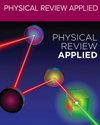液压消音器的材料设计
IF 4.4
2区 物理与天体物理
Q2 PHYSICS, APPLIED
引用次数: 0
摘要
降低液压动力系统中的流体噪声对机器的可靠性和人类的舒适性都至关重要。一种典型的方法是使用顺应性内联液压消音器来降低设备内的声速,例如加压气囊或合成泡沫。然而,对用于消音器设计的创新顺应性材料的探索一直很有限;这主要是由于缺乏一个可容纳大量各向异性材料的综合模型来评估液压消音器的性能。在这项工作中,我们为消音器设计开发了一个包含各向异性反射材料的通用分析模型。该模型使我们能够在更广泛的材料范围内确定优化解决方案,以满足耐压要求。基于这些见解,我们设计并制造了一种各向异性的低阻抗顺应金属晶格,并将其作为反射材料集成到液压消音器中。实验结果表明,在 100 Hz 至 2 kHz 的频率范围内,该消音器的平均传声损耗为 21 dB,与我们提出的模型预测结果十分吻合。这项工作为选择和设计用于缓解液压噪声的创新材料铺平了道路。本文章由计算机程序翻译,如有差异,请以英文原文为准。

Material design for hydraulic silencers
Mitigation of fluid-borne noise in hydraulic power systems is of paramount importance for both machine reliability and human comfort. One typical approach involves using compliant inline hydraulic silencers to lower the sound speed within devices, e.g., pressurized bladders or syntactic foams. However, the exploration of innovative compliant materials for silencer designs has been limited; this is largely due to the absence of a comprehensive model that can accommodate a large range of anisotropic materials to evaluate the performance of hydraulic silencers. In this work, we develop a general analytical model for silencer design that incorporates anisotropic reflective materials. The model enables us to identify optimized solutions within a broader material spectrum, tailored to meet pressure-resistance requirements. Building upon these insights, we design and fabricate an anisotropic compliant metallic lattice with low impedance and integrate it into a hydraulic silencer as the reflective material. Experimental results demonstrate that this silencer can achieve an average sound-transmission loss of 21 dB across a frequency range of 100 Hz to 2 kHz, in good agreement with predictions from our proposed model. This work paves the way for selecting and designing innovative materials for the mitigation of hydraulic noise.
求助全文
通过发布文献求助,成功后即可免费获取论文全文。
去求助
来源期刊

Physical Review Applied
PHYSICS, APPLIED-
CiteScore
7.80
自引率
8.70%
发文量
760
审稿时长
2.5 months
期刊介绍:
Physical Review Applied (PRApplied) publishes high-quality papers that bridge the gap between engineering and physics, and between current and future technologies. PRApplied welcomes papers from both the engineering and physics communities, in academia and industry.
PRApplied focuses on topics including:
Biophysics, bioelectronics, and biomedical engineering,
Device physics,
Electronics,
Technology to harvest, store, and transmit energy, focusing on renewable energy technologies,
Geophysics and space science,
Industrial physics,
Magnetism and spintronics,
Metamaterials,
Microfluidics,
Nonlinear dynamics and pattern formation in natural or manufactured systems,
Nanoscience and nanotechnology,
Optics, optoelectronics, photonics, and photonic devices,
Quantum information processing, both algorithms and hardware,
Soft matter physics, including granular and complex fluids and active matter.
 求助内容:
求助内容: 应助结果提醒方式:
应助结果提醒方式:


